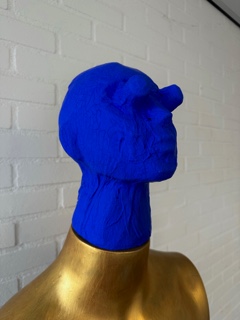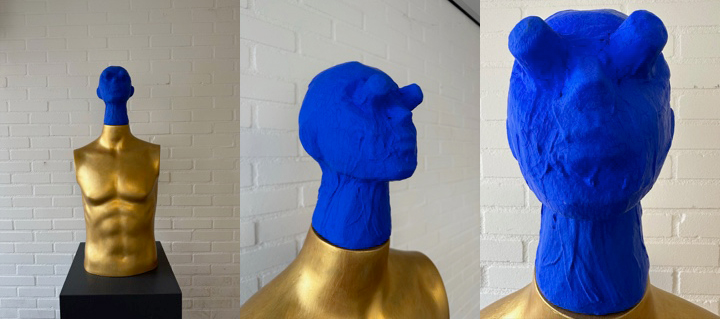Arie Otten (1954) is a self-taught visual artist based in Apeldoorn, Netherlands. His art is a captivating journey through the realms of abstract painting, embracing a diverse range of disciplines. With unwavering passion and a spirit of artistic freedom, Otten experiments with an array of techniques and materials, including acrylics, oils, and organic pigments. Starting with a blank canvas or panel, he embarks on a creative odyssey, allowing his ideas to take shape through experimentation. Otten’s work frequently delves into the human experience, where faces emerge as compelling subjects. Additionally, he crafts abstracted landscapes and other enigmatic impressions, evoking a world of boundless imagination.

Otten’s work often goes beyond traditional painting, venturing into the realm of sculpture. His piece, “Big Blue Eyes,” is a testament to his creative approach and his commitment to sustainability in art. This sculpture is an intriguing mix of materials, each chosen for its texture, color, and potential to convey deeper meaning.

The base of “Big Blue Eyes” is a used mannequin torso, a found object that Otten transformed into a piece of art. The torso serves as the foundation, which he coated with layers of gold paint. This gold layer adds an element of luxury and timelessness to the sculpture, creating a contrast with the used materials that make up the rest of the piece. The use of gold also suggests a certain reverence for the materials themselves, elevating them from everyday objects to something more profound.

On top of the mannequin torso, Otten placed a head made of cast plastic. This head is where the sculpture begins to take on its unique personality. The eyes, made from Nespresso coffee cups, are perhaps the most attention-grabbing aspect of the piece. These bulging eyes give the sculpture an almost surreal quality, inviting viewers to consider what the eyes are seeing or what emotions they might convey. The choice of coffee cups as eyes is a clever use of everyday materials, transforming them into something both familiar and strange.
To add further texture and depth, Otten wrapped the head in used household wipes. These wipes, glued in place with a secret adhesive mixture of his own creation, create a veined texture that mimics the natural lines and wrinkles of skin. This gives the head a lifelike quality, as though it has been weathered by time and experience. The texture created by the wipes adds a tactile element to the sculpture, inviting viewers to imagine what it might feel like to touch the piece.
The finishing touch on “Big Blue Eyes” is the application of Ultramarine acrylic paint, mixed with extra pigment to create a powdery texture. This shade of blue has a long history in art, often associated with the divine or the infinite. By choosing this color, Otten adds a spiritual dimension to the piece, suggesting that the sculpture is more than just a collection of repurposed materials; it is a meditation on the nature of existence and perception.
“Big Blue Eyes” is more than just a sculpture; it is a statement about the potential of everyday objects to be transformed into art. Otten’s use of repurposed materials challenges traditional notions of what is considered valuable or worthy of artistic attention. By taking objects that might otherwise be discarded and turning them into something new, he encourages viewers to rethink their own relationship with the material world.
In conclusion, Arie Otten’s work is a blend of creativity, experimentation, and a deep respect for the materials he uses. “Big Blue Eyes” is a perfect example of how he transforms ordinary objects into art that invites contemplation and conversation. Through his work, Otten challenges us to see the world differently, to find beauty and meaning in the everyday, and to appreciate the endless possibilities that art offers.

